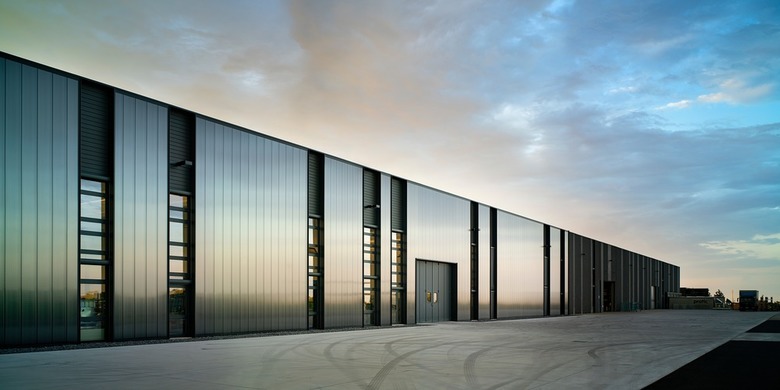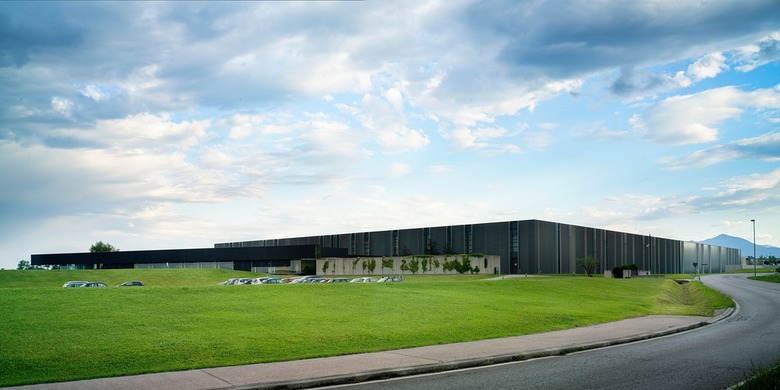PRATIC 2.0
The Pratic Headquarters dialogue with the earth and the sky, with light and shadow.
Location: Fagagna, Udine, Italy
Client: Pratic F.lli Orioli Spa
Architect and Landscape: GEA Gri e Zucchi Architettura srl
Project Manager: Stefania Anzil
Project Team: Alessia Dorigo, Matteo Compri, Elisa Mansutti
Structural: Ing. A. Nutta, Nuttassociati
Mechanical and Electrical: E4F Srl
Acoustical: Studio Musolla
Contractors:
Pre-Systems Spa (prefabricated structure)
Slurry Srl (landscape and building works)
Vaportermica Commerciale Srl (Mechanical plants)
Impresa Tonon Spa (Electrical plants)
Pavarin F.lli Snc (Window frames and facade cladding)
Iron+ Srl (carpentry works)
Multitema Srl (Interior finishings and furniture)
Adotta Italia Srl (System walls)
The productive and directional functions relate to the landscape without mimicry. The spaces are designed with the aim of establishing a constant relationship between interior and exterior. Thus Pratic becomes the landmark of the landscape.
The Pratic Spa, a manufacturer of solar shading systems, is an industrial site where the architecture for production becomes a contribution to the landscape and reinforces its identity.
The intervention involves and integrates industrial volumes and vast open spaces. The buildings are related to the earth and the sky, with light and shadow. The productive and directional functions relate to the landscape without mimicry, and the spaces are designed with the aim of establishing a constant dialogue between inside and outside. The building thus becomes a comfortable and functional landmark. The typological plant includes an office building, a showroom, research and innovation laboratories, spaces for production, painting and warehouses, a wellness area for employees. All these functions are linked by the design of open spaces and parking lots, defined by the embankments modeled along the roads, by the spaces dedicated to relaxation and meeting, by the control of the views on the landscape. It is an industrial building in constant relation with the natural landscape.
The headquarters were built in two phases: the first in 2011 and the subsequent expansion in 2018.
The enlargement of the Pratic, built in adherence to the industrial building of the first lot, is a complex project, despite apparently showing an essential character. This is a rectangular building of about 9.000 sqm that completes and improves the existing production department built in 2011. The functional program is almost the same of the previous building: offices, services, canteen, wellness area, production, warehouses, painting plant, as well as parking areas and service areas included in the rigorous design of the open spaces.
The new building consists of two simple elements: the rhythm given by the windows, which repeats and declares continuity with the existing facade, and the reflecting skin, which dissolves the new volume in the sky. The first lot, black and grainy, seems to arise from the ground, settling the building in place; the second lot, always black but reflective and iridescent, mirrors the landscape and the light with images that are always different due to weather variability. The first one is “heavy” and permanent, in search of eternity, the second one is “light” and changeable, ready to dissolve in the sky: the building completed the molt of its skin.
The facade consists of a single material, of a unique size: a 4 centimeters thick polycarbonate panel, about 10 meters high, fixed to prefabricated concrete structure. The polycarbonate panels are customized in order to obtain a reflecting facade when seen from afar and “deep” when observed closely. The panels consist of two different types of polycarbonate combined together: the rear side has an opaque compound which impedes the light to pass through, while the front is “frozen”. In this way the load-bearing structure is completely hidden behind the cladding system and the verticality of the new facade sets up an interesting dialogue with the black concrete panels of the existent building. From afar the building reflects the sky and appears cladded by huge glass plates, while close up it looks “lighter”, maintaining a dialogue with the pre-existence. The mirroring of the panels also ensures a continuous color variation of the facades: depending on the time of the day and varying in light intensity the building may appear black, golden, metallic, opaque, glossy, infinitely variable.
The entire settlement is included in the architectural design of the landscape and open spaces. Places designed for relaxation, pedestrian paths and parking lots are enclosed in the design of the “modified embankments” that insert subtle variations of slope with respect to the roads and access roads. In this way, the project is inserted in the ground in a clear way, highlighting the shape and geometry of the territory. The building demonstrates that industrial architecture can add value to the landscape and improve the quality of the workplace. This is a great opportunity to rethink the relationship between architecture and nature, putting man back in the middle.
Artículos relacionados
-
Cocoon Pre-primary Extension at Bloomingdale International School
andblack design studio | 19.08.2024 -
-
-
-













